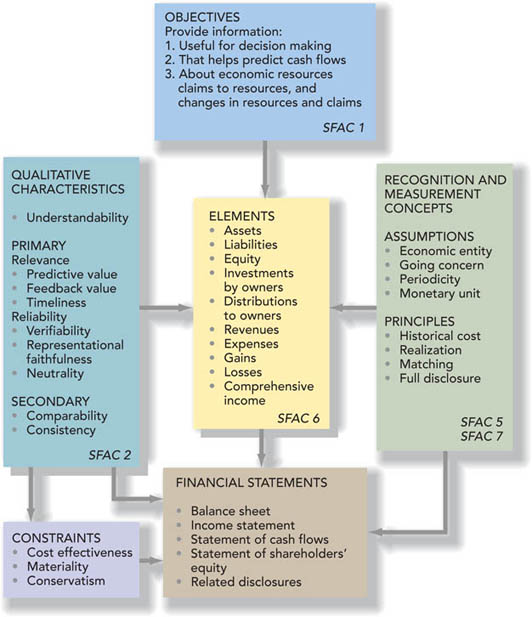
(See related pages)
The increasing complexity of our business world creates growing pressure on the FASB to delicately balance the many constituents of the accounting standard-setting process. The task of the FASB is made less complex if there exists a set of cohesive objectives and fundamental concepts on which financial accounting and reporting can be based. A number of years after coming into existence in 1973, the FASB’s efforts resulted in the establishment of these objectives and concepts.
lLO5 The conceptual frameworkdeals with theoretical and conceptual issues and provides an underlying structure for current and future accounting and reporting standards. has been described as a constitution, a coherent system of interrelated objectives and fundamentals that can lead to consistent standards and that prescribe the nature, function, and limits of financial accounting and reporting. The fundamentals are the underlying concepts of accounting, concepts that guide the selection of events to be accounted for, the measurement of those events, and the means of summarizing and communicating them to interested parties.25
The FASB has disseminated this framework through seven Statements of Financial Accounting Concepts. SFAC 4 deals with the objectives of financial reporting for nonprofit organizations, and SFAC 3 was superseded by SFAC 6, which, with the other four statements, is discussed below. It is important to realize that the conceptual framework provides structure and direction to financial accounting and reporting and does not directly prescribe GAAP.
The financial statements and their elements are most informative when they possess specific qualitative characteristics, subject to the constraints of materiality, cost effectiveness, and conservatism. Proper recognition and measurement of financial information rely on several assumptions and principles that underlie the financial reporting process. The remainder of this chapter is devoted to discussions of the components of the conceptual framework that bear on financial statements as depicted in Graphic 1-5, beginning with the objectives of financial reporting.
Exercises E1-13 25 “Conceptual Framework for Financial Accounting and Reporting: Elements of Financial Statements and Their Measurement,” Discussion Memorandum (Stamford, Conn.: FASB, 1976), p. 2. 26 Introduction to “Objectives of Financial Reporting by Nonbusiness Organizations,” Statement of Financial Accounting Concepts No. 4 (Stamford, Conn.: FASB, 1980). |
